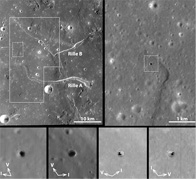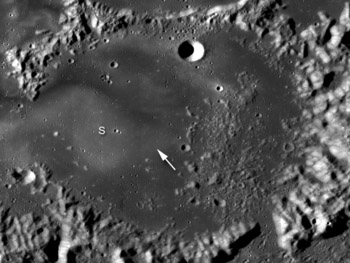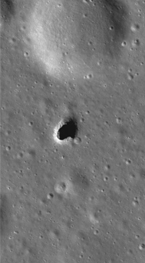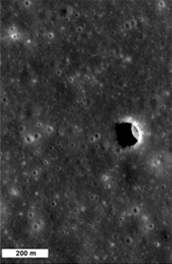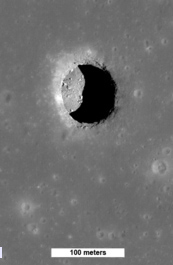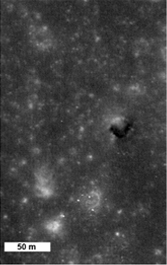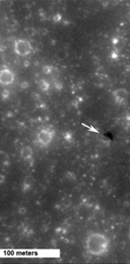Difference between revisions of "Skylights"
| (One intermediate revision by the same user not shown) | |||
| Line 1: | Line 1: | ||
<div id="content_view" class="wiki" style="display: block"> | <div id="content_view" class="wiki" style="display: block"> | ||
=Skylights= | =Skylights= | ||
| − | [http://lroc.sese.asu.edu/news/uploads/LROCiotw/M114328462R_enlargement.png [[Image: | + | [http://lroc.sese.asu.edu/news/uploads/LROCiotw/M114328462R_enlargement.png [[Image:Skylight-small.jpg|skylight-small.jpg]]]<br /> ''[[LRO|LROC]] view, '''NAC M114328462R''', of a skylight in the Marius Hills from [http://lroc.sese.asu.edu/ NASA/GSFC/Arizona State University]''.<br /> <div id="toc"> |
| − | + | ||
| − | |||
==Description== | ==Description== | ||
Skylights are collapses that occur over subsurface voids. They have been known for 30-40 years to occur in uncollapsed sections of rilles. The previously known pits are typically a few kilometers across. Smaller ones have recently been detected by Kaguya and LRO, leading to renewed interest. Skylights occur in many terrestrial lava tubes, providing access, although sometimes requiring shimming down a rope. If the skylight roof is too thin, their edges may collapse, making them dangerous places to stand. This site will provide information on small (and even large) skylights as they become known.<br /> <br /> | Skylights are collapses that occur over subsurface voids. They have been known for 30-40 years to occur in uncollapsed sections of rilles. The previously known pits are typically a few kilometers across. Smaller ones have recently been detected by Kaguya and LRO, leading to renewed interest. Skylights occur in many terrestrial lava tubes, providing access, although sometimes requiring shimming down a rope. If the skylight roof is too thin, their edges may collapse, making them dangerous places to stand. This site will provide information on small (and even large) skylights as they become known.<br /> <br /> | ||
| Line 11: | Line 10: | ||
* Discovered on Kaguya images (below) by Junichi Haruyama, and then seen in more detail with LRO (above). | * Discovered on Kaguya images (below) by Junichi Haruyama, and then seen in more detail with LRO (above). | ||
* [[Kaguya|Kaguya-Selene]] view below of [[Marius%20Hills|Marius Hills]] skylight (click image to go to Kaguya page). | * [[Kaguya|Kaguya-Selene]] view below of [[Marius%20Hills|Marius Hills]] skylight (click image to go to Kaguya page). | ||
| − | ** [http://wms.selene.jaxa.jp/selene_viewer/en/observation_mission/tc/039/tc_039.jpg [[Image: | + | ** [http://wms.selene.jaxa.jp/selene_viewer/en/observation_mission/tc/039/tc_039.jpg [[Image:Kaguya-mariussmall.jpg|kaguya-mariussmall.jpg]]] |
* The '''Marius Hills Skylight''' is noticeable on Lunar Orbiter 5's medium resolution (med) photographs [http://www.lpi.usra.edu/resources/lunarorbiter/frame/?5211 LOV-211-med], [http://www.lpi.usra.edu/resources/lunarorbiter/frame/?5212 LOV-212-med], [http://www.lpi.usra.edu/resources/lunarorbiter/frame/?5213 LOV-213-med], [http://www.lpi.usra.edu/resources/lunarorbiter/frame/?5214 LOV-214-med], [http://www.lpi.usra.edu/resources/lunarorbiter/frame/?5215 LOV-215-med], and [http://www.lpi.usra.edu/resources/lunarorbiter/frame/?5216 LOV-216-med], although one should have very good eyes to detect the "pit" on the online Hi-Res scans of these photographs! | * The '''Marius Hills Skylight''' is noticeable on Lunar Orbiter 5's medium resolution (med) photographs [http://www.lpi.usra.edu/resources/lunarorbiter/frame/?5211 LOV-211-med], [http://www.lpi.usra.edu/resources/lunarorbiter/frame/?5212 LOV-212-med], [http://www.lpi.usra.edu/resources/lunarorbiter/frame/?5213 LOV-213-med], [http://www.lpi.usra.edu/resources/lunarorbiter/frame/?5214 LOV-214-med], [http://www.lpi.usra.edu/resources/lunarorbiter/frame/?5215 LOV-215-med], and [http://www.lpi.usra.edu/resources/lunarorbiter/frame/?5216 LOV-216-med], although one should have very good eyes to detect the "pit" on the online Hi-Res scans of these photographs! | ||
** Is it possible to create a three-dimensional stereo view of this skylight while looking at extreme close ups of LOV-211-med and LOV-215-med? (warning: LOV-216-med shows too much blur, and can't be used). | ** Is it possible to create a three-dimensional stereo view of this skylight while looking at extreme close ups of LOV-211-med and LOV-215-med? (warning: LOV-216-med shows too much blur, and can't be used). | ||
| Line 30: | Line 29: | ||
{| class="captionBox" style="float: left" | {| class="captionBox" style="float: left" | ||
| class="captionedImage" | | | class="captionedImage" | | ||
| − | [http://wms.lroc.asu.edu/lroc_browse/view/M128202846LE [[Image: | + | [http://wms.lroc.asu.edu/lroc_browse/view/M128202846LE [[Image:Ingenii-closeup.jpg|ingenii-closeup.jpg]]] |
|- | |- | ||
| class="imageCaption" | NAC M128202846LE Mare Ingenii (close-up) | | class="imageCaption" | NAC M128202846LE Mare Ingenii (close-up) | ||
| Line 43: | Line 42: | ||
{| class="captionBox" style="float: left" | {| class="captionBox" style="float: left" | ||
| class="captionedImage" | | | class="captionedImage" | | ||
| − | [http://lroc.sese.asu.edu/news/uploads/M106662246R_thumb.png [[Image: | + | [http://lroc.sese.asu.edu/news/uploads/M106662246R_thumb.png [[Image:Tranquillitatis1.jpg|tranquillitatis1.jpg]]] |
|- | |- | ||
| class="imageCaption" | NAC M106662246R | | class="imageCaption" | NAC M106662246R | ||
| Line 50: | Line 49: | ||
{| class="captionBox" style="float: left" | {| class="captionBox" style="float: left" | ||
| class="captionedImage" | | | class="captionedImage" | | ||
| − | [http://lroc.sese.asu.edu/news/uploads/M126710873RE_map_thumb.png [[Image: | + | [http://lroc.sese.asu.edu/news/uploads/M126710873RE_map_thumb.png [[Image:Skylight-tranquilitatis.jpg|skylight-tranquilitatis.jpg]]] |
|- | |- | ||
| class="imageCaption" | NAC M126710873R | | class="imageCaption" | NAC M126710873R | ||
| Line 57: | Line 56: | ||
{| class="captionBox" style="float: left" | {| class="captionBox" style="float: left" | ||
| class="captionedImage" | | | class="captionedImage" | | ||
| − | [http://lroc.sese.asu.edu/news/uploads/M124382509L_ppit.png [[Image: | + | [http://lroc.sese.asu.edu/news/uploads/M124382509L_ppit.png [[Image:Tranquillitatis2.jpg|tranquillitatis2.jpg]]] |
|- | |- | ||
| class="imageCaption" | NAC M124382509L | | class="imageCaption" | NAC M124382509L | ||
| Line 64: | Line 63: | ||
{| class="captionBox" style="float: left" | {| class="captionBox" style="float: left" | ||
| class="captionedImage" | | | class="captionedImage" | | ||
| − | [http://lroc.sese.asu.edu/news/uploads/M109100697R_pit.png [[Image: | + | [http://lroc.sese.asu.edu/news/uploads/M109100697R_pit.png [[Image:Tranquillitatis3.jpg|tranquillitatis3.jpg]]] |
|- | |- | ||
| class="imageCaption" | M109100697R | | class="imageCaption" | M109100697R | ||
| Line 71: | Line 70: | ||
* Discovered by LRO team. | * Discovered by LRO team. | ||
| − | * The first one of the three depicted skylights in '''Mare Tranquillitatis''' (the image at left) is located about two degrees east-southeast of crater '''Sinas''' (northeast of '''Sinas A''', about halfway between '''Sinas A''' and '''Sinas G'''). The second image is a close-up view of the first image. It should be mentioned that the brightest ones of the small ray-craterlets which are captured in the LRO's vertical swath (containing the skylight at left) are also noticeable as tiny white specks on page 122 of B.Bussey's and P.Spudis's ''Clementine Atlas of the Moon'' (LAC 61).<span class="membersnap">- | + | * The first one of the three depicted skylights in '''Mare Tranquillitatis''' (the image at left) is located about two degrees east-southeast of crater '''Sinas''' (northeast of '''Sinas A''', about halfway between '''Sinas A''' and '''Sinas G'''). The second image is a close-up view of the first image. It should be mentioned that the brightest ones of the small ray-craterlets which are captured in the LRO's vertical swath (containing the skylight at left) are also noticeable as tiny white specks on page 122 of B.Bussey's and P.Spudis's ''Clementine Atlas of the Moon'' (LAC 61).<span class="membersnap">- DannyCaes <small>Jul 17, 2010</small></span> |
| − | * The '''''Sinas Skylight''''' (unofficially named by Danny Caes) is also detectable on close-ups of several of Apollo 15's orbital mapping/metric ''Fairchild''-camera photographs which were made in july 1971.<span class="membersnap">- | + | * The '''''Sinas Skylight''''' (unofficially named by Danny Caes) is also detectable on close-ups of several of Apollo 15's orbital mapping/metric ''Fairchild''-camera photographs which were made in july 1971.<span class="membersnap">- DannyCaes <small>Jul 18, 2010</small></span> |
{| class="wiki_table" | {| class="wiki_table" | ||
| | | | ||
{| class="captionBox" style="float: left" | {| class="captionBox" style="float: left" | ||
| class="captionedImage" | | | class="captionedImage" | | ||
| − | [[Image: | + | [[Image:Skylights.jpg|skylights.jpg]] |
|- | |- | ||
| class="imageCaption" | The unofficially-named "Sinas Skylight" as discovered in Apollo 15 image No. AS15-M-2278 by Danny Caes | | class="imageCaption" | The unofficially-named "Sinas Skylight" as discovered in Apollo 15 image No. AS15-M-2278 by Danny Caes | ||
| Line 99: | Line 98: | ||
[https://en.wikipedia.org/wiki/Hollow_Moon Hollow Moon]<br /> <br /> | [https://en.wikipedia.org/wiki/Hollow_Moon Hollow Moon]<br /> <br /> | ||
---- | ---- | ||
| − | + | </div> | |
Latest revision as of 02:17, 16 April 2018
Contents
Skylights
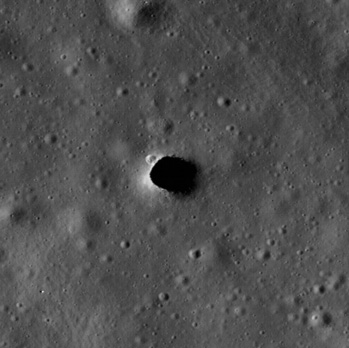
LROC view, NAC M114328462R, of a skylight in the Marius Hills from NASA/GSFC/Arizona State University.
Description
Skylights are collapses that occur over subsurface voids. They have been known for 30-40 years to occur in uncollapsed sections of rilles. The previously known pits are typically a few kilometers across. Smaller ones have recently been detected by Kaguya and LRO, leading to renewed interest. Skylights occur in many terrestrial lava tubes, providing access, although sometimes requiring shimming down a rope. If the skylight roof is too thin, their edges may collapse, making them dangerous places to stand. This site will provide information on small (and even large) skylights as they become known.
Description Wikipedia
Marius Hills Skylight, aka the Haruyama pit
- Discovered on Kaguya images (below) by Junichi Haruyama, and then seen in more detail with LRO (above).
- Kaguya-Selene view below of Marius Hills skylight (click image to go to Kaguya page).
- The Marius Hills Skylight is noticeable on Lunar Orbiter 5's medium resolution (med) photographs LOV-211-med, LOV-212-med, LOV-213-med, LOV-214-med, LOV-215-med, and LOV-216-med, although one should have very good eyes to detect the "pit" on the online Hi-Res scans of these photographs!
- Is it possible to create a three-dimensional stereo view of this skylight while looking at extreme close ups of LOV-211-med and LOV-215-med? (warning: LOV-216-med shows too much blur, and can't be used).
- If Lunar-Orbiter 5's Hi-Res close up photograph LOV-214-h3was made several kilometers more westward, it would have captured the skylight described above. Unfortunately, it (the location of the skylight) is "off screen" beyond the photograph's upper margin, which shows only the eastern part of the "elbow" in the skylight's rille.
- Research Lunar-Orbiter 5 photography: Danny Caes
- Image of the Marius Hills skylight with sunlight shining on the floor, reported by James Fincannon in LROC frame M122584310LE.
Mare Ingenii Skylight
|
|
- Discovered by LRO team.
Mare Tranquillitatis Skylights
|
|
|
|
- Discovered by LRO team.
- The first one of the three depicted skylights in Mare Tranquillitatis (the image at left) is located about two degrees east-southeast of crater Sinas (northeast of Sinas A, about halfway between Sinas A and Sinas G). The second image is a close-up view of the first image. It should be mentioned that the brightest ones of the small ray-craterlets which are captured in the LRO's vertical swath (containing the skylight at left) are also noticeable as tiny white specks on page 122 of B.Bussey's and P.Spudis's Clementine Atlas of the Moon (LAC 61).- DannyCaes Jul 17, 2010
- The Sinas Skylight (unofficially named by Danny Caes) is also detectable on close-ups of several of Apollo 15's orbital mapping/metric Fairchild-camera photographs which were made in july 1971.- DannyCaes Jul 18, 2010
|
Left: LAC 61, Middle two: AS15-M-2278, Right: LROC.
LROC Articles
Marius Hills Pit - Lava Tube Skylight?
Depths of Mare Ingenii
How Common are Mare Pit Craters
New Views of Lunar Pits
Natural Bridge on the Moon!
Sublunarean Void!
Impact Melt Pit
Copernicus Collapse
Mare Pit Topography! (Skylight in central Mare Fecunditatis, immediately east of Messier B).
Louville D
LPOD Articles
APOD Articles
- Skylights on the Moon:
Marius Hills and a Hole in the Moon
- Skylights on Mars:
A Hole in Mars (a Martian black hole!).
A Hole in Mars, close up (a true Martian Skylight).
A Hole in Mars (located at the centre of a bowl-shaped crater).
Bibliography
Lee, P. (2018) Possible Lava Tube Skylights Discovered Near The North Pole of the Moon - SETI Institute and Mars Institute on 11 January 2018.
